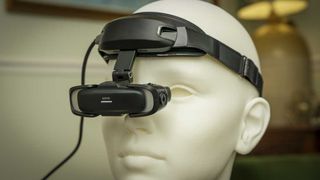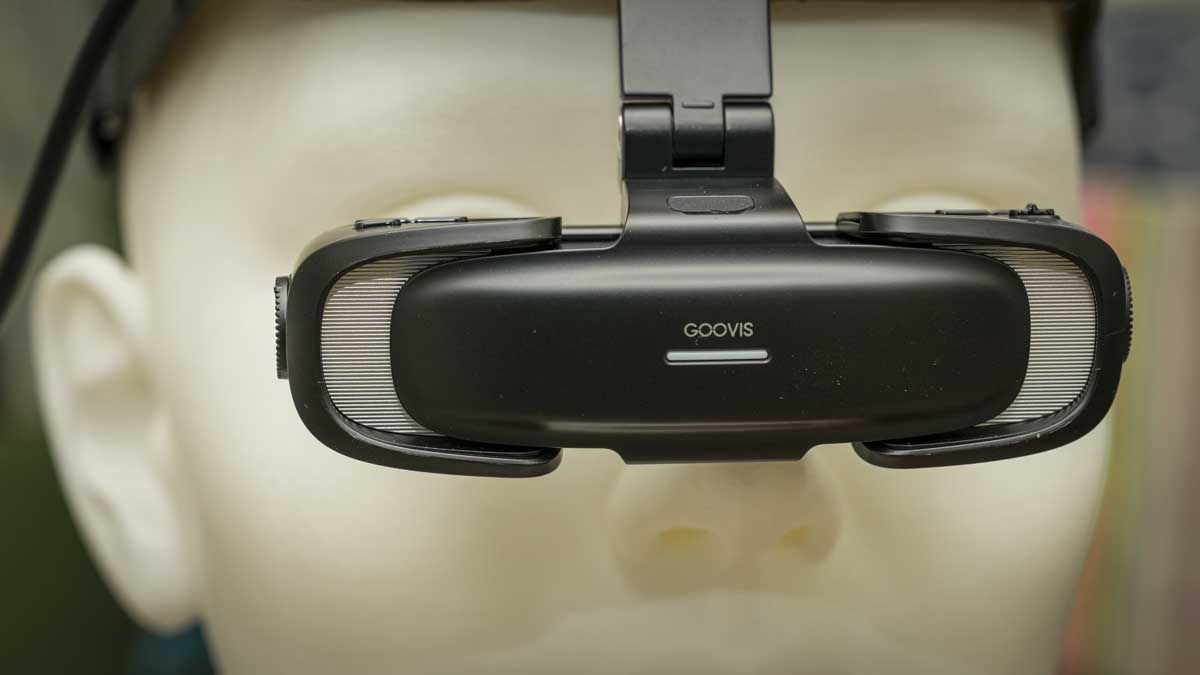
Goovis Art (A1) 3D Head Mounted Display: 30-second review
Specs
Display: 2 x Micro-OLED binocular
Resolution: 1920×1080
Refresh rate: 60hz
Display PPI: 4496
Virtual screen size: 110-inch giant screen at 4M
Main body weight: 110g
Optical solution: Multiple Aspheric lenses
Field of view: 40º
IPD: 58-74mm
Audio: 3.5mm / Built-in speaker
Connection cable: Type-C
The Goovis Art (A1) 3D is designed as a lightweight and portable headset that offers both 2D and 3D stereoscopic playback in an open design. This makes it an ideal choice for business travellers who can’t take a large and bulky VR headset in their luggage but still want something more immersive than a mobile phone, tablet or laptop to watch back media. This headset essentially enables you to expand your device’s screen space from a few inches to a virtual 110″ display ideal for watching back movies as well as gaming. It also has a few more professional applications, including being used in combination with a camera as a way to monitor a scene’s composition and grading as and when you film.
Compared to the bulk of other headsets, the Goovis Art (A1) 3D is incredibly small and lightweight, and this is possible due to the relatively simple nature of the design. For example, it draws power from the connected device rather than having a built-in power supply, though an optional power bank is available, and likewise, there’s no OS installed. It is just a form of display. Because of this, setting up the headset is quick, with no need for an app or complicated procedures. Simply use the USB Type-C cable to connect to a compatible device—essentially, any device that supports display output through the USB port. This includes devices like MacBooks, most laptops, tablets, and phones, including the iPhone 15 and 16 Pro.
Once connected, the headset is instantly recognised as a monitor and displays the content of the screen on the two small OLED screens within the headset. You can adjust the display settings as you would with a standard monitor using the display options on your device. The headset itself offers a few adjustments for brightness, volume, focus and fit, as well as switching from 2D to 3D.
Eye comfort is a key consideration, and the headset provides plenty of adjustment. It features diopter adjustments on each side, allowing you to fine-tune the focus for each eye. Additionally, you can adjust the interpupillary distance to ensure a comfortable fit. If you wear glasses, then the open design offers enough space to accommodate regular glasses, making the headset accessible to users with vision needs beyond the built-in adjustments.
While the straightforward 2D visual display will attract most users, the ability to view 3D stereoscopic footage adds another dimension to the device. On a standard display, this footage appears as two side-by-side images, but through the headset, once the button is pushed, it transforms into a pseudo-3D representation. This technique, which mimics human eye positioning, has been used since the Victorian era to great effect.
In addition to visuals, the headset offers basic audio options. It includes a standard 3.5mm audio jack for headphones and two built-in speakers that deliver surprisingly decent audio quality, given their size.
In use, the headset performs well, offering good visual and audio quality for watching videos and playing games. However, it does take some getting used to, and while you can settle into the immersive feel with games and movies, it’s not designed to be used to update documents or browse the internet; this is a media display rather than general use. Regardless of the application, it takes time for your mind to adjust to the small screens that are creating that large-screen-equivalent view. Once you do, the ability to maintain peripheral vision becomes highly useful. Where it really comes into it’s own is when you only have a small phone screen and want to see the detail on something bigger and higher quality.
The headset is particularly handy for creatives. It serves not only as a viewer for stereoscopic footage but also as a tool for live video composition while filming. The Full HD screens provide a high-quality preview of footage directly from the camera (via an HDMI adapter), enabling you to assess composition, colour grading, and action in real time.
The Goovis Art (A1) 3D Head Mounted Display does take some getting used to, and the open design won’t appeal to everyone, as it doesn’t provide the fully immersive experience offered by other models. However, for businesses and creatives, its lightweight and portable nature offers incredible potential for the right use scenarios.
Goovis Art (A1) 3D Head Mounted Display: Price & availability
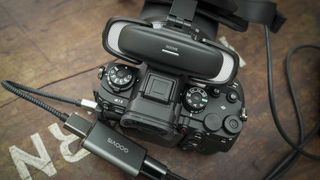
At a standard price of $699, the Goovis Art (A1) 3D Head Mounted Display is expensive, but few other headsets offer this level of compactness and simplicity. The headset, along with accessories, is available directly from the Goovis website by clicking here, as well as from major online retailers. The headset is also available in both black and white.
- Score: 4/5
Goovis Art (A1) 3D Head Mounted Display: Design & build
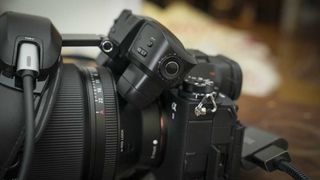
At 110 g, the Goovis Art (A1) 3D Head Mounted Display is one of the lightest headsets available. Its simple design makes it extremely versatile and easy to use and enables it to fit comfortably into a backpack or bag; in contrast to the larger enclosed systems, it’s a fraction of the size.
The main unit consists of a headset and a head strap with a removable forehead pad. The strap is fully adjustable, ensuring a comfortable fit around the head. The headset utilises a hanging design, which means the screens are suspended from the head strap and can be flipped up or down as needed, offering plenty of flexibility in positioning. This design ensures the screens sit away from your face, providing ample peripheral vision so you can remain aware of your surroundings. If you wear prescription glasses, then you can still wear these when using the headset.
The hanging design not only gives flexibility over screen positioning but also allows adjustment of the width or distance between the two screens by pulling them apart, known as the pupillary distance. This adjustment ranges from 58 mm to 74 mm, making the headset suitable for most users. Once positioned, the diopters on the sides of the headset enable individual adjustments of the internal optics, ensuring clear vision. It’s worth pointing out that while there are two small OLED screens, the design means that they come together as one when using the headset. This also enables the headset to create the 3D Stereoscopic effect with the right type of footage, which is viewable once you tap the 2D to 3D button on the top of the set.
The headset itself is incredibly simple, functioning solely as a display. It features no internal capabilities beyond brightness and volume adjustments. Video and audio input, along with power, are supplied via a USB Type-C cable, which connects to any device with DP output. For example, when connected to an iPhone 15 Pro using the included USB Type-C cable, the unit automatically powers on when placed on the head. A small sensor in the middle of the eyepiece detects when the headset is in use, turning the screens on and off to conserve the power of the connected device.
To boost functionality, Goovis offers a range of accessories, such as a power bank that connects the device and the headset to supply power. Other accessories include a smart TV module and a USB-to-HDMI adapter, both of which expand the headset’s potential. For this test, the full range of accessories was used to explore the headset’s capabilities.
For standard use, the USB Type-C connection suffices for connecting to computers, phones, and tablets. However, when using the headset with cameras or other creative equipment, the HDMI-to-USB Type-C adapter is necessary.
Aside from the USB Type-C port, the headset features a 3.5 mm audio-out port for standard headphones. It also includes two built-in speakers. While small, these speakers deliver a decent audio experience for casual use without headphones.
The headset is designed to be simple, lightweight, and easy to use for both personal and professional applications.
- Design: 4/5
Goovis Art (A1) 3D Head Mounted Display: Features
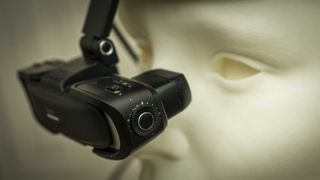
While many headsets come equipped with smart TV features, built-in battery packs, and other extras, the Goovis Art (A1) 3D Head Mounted Display takes a minimalist approach. With this headset, you get the core system, which you can adapt to suit your needs. In its simplest form, it functions as a headset display—pop it on, and you have the equivalent of a 110-inch screen wherever you are. If you want to travel light, an iPhone, a long USB Type-C cable, and the headset are all you need. Connect it, and you can start immediately. For audio, plug in headphones through the 3.5mm jack. If you want Smart TV capabilities, there’s a module for that, along with an HDMI-to-Type-C adapter and a power bank. Essentially, the headset serves as a core unit that you can customise and build upon for your intended use. At its smallest and lightest, it fits easily into a backpack’s side pocket, weighing only 110 g and folding down compactly.
Beyond the plug-and-play simplicity, the headset includes additional features that enhance its usability. The hanging design offers flexibility in screen positioning and accommodates users who wear glasses. In terms of compatibility, the headset works with any device featuring USB Type-C with DisplayPort (DP) support. The USB Type-C to HDMI adapter can also connect to any device with an HDMI port, making it compatible with Steam Deck, Switch, PS5, Apple, Android, Windows devices, Xbox Series X|S, and more.
One of the major advantages of the open-frame design is that it allows for ultra-wide peripheral vision, enabling you to stay aware of your surroundings while using the screens.
For personalising the fit, the headset provides adjustable interpupillary distance (from 58 mm to 74 mm) and diopter adjustments for each lens, ranging from 0 to 350º. Additional on-headset adjustments include brightness and volume adjustments, as well as the ability to switch between 2D and 3D stereoscopic modes.
Each eyepiece features a 1920×1080 OLED screen, creating the virtual equivalent of a 110-inch display with a 60 Hz refresh rate and 110% RGB colour gamut.
While the core of the headset is just a display for 2D and 3D media, it can be enhanced with a range of accessories, including a Smart TV dongle, HDMI adapter, and additional fitting options for enhanced comfort and usability. This adaptability makes the Goovis Art (A1) an exceptionally versatile choice for both personal and professional applications.
- Features: 4/5
Goovis Art (A1) 3D Head Mounted Display: Performance
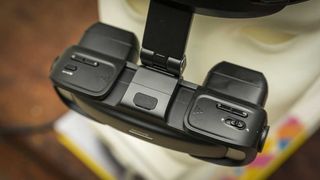
Compared to most headsets, the Goovis Art (A1) 3D Head Mounted Display is small and lightweight. It packs down easily into a bag, allowing you to take it with you without adding much weight or bulk. The simplicity of the headset is another highlight. Essentially, it’s just the headset and one USB Type-C cable that connects to whichever device you want to use, whether that’s a phone, computer, or camera. In this test, we used the headset with an iPhone 15 Pro, iPad Mini, Vivo X100, MacBook Air M2 13″ and Sony A1 II, well why not!
The first test involved mobile devices to see how the headset performed for media playback and general use. Once plugged in and the headset was worn, the two small screens powered up, mirroring the display of the connected device. Thanks to the hanging design and lightweight construction, the headset is incredibly comfortable to wear and doesn’t feel bulky or heavy like other devices.
The benefits of the open design are immediately apparent, offering greater versatility by allowing you to maintain peripheral vision. While this design is less immersive than fully enclosed headsets, it is far better suited to work environments or situations where you need to remain aware of your surroundings. This feature also opens up other use cases beyond simple media playback, which we’ll discuss in a bit.
With a phone plugged in, the headset displays a vertical screen showing the phone’s interface. Initial set-up involves adjusting the interpupillary distance (the distance between your eyes) by sliding the screens into position. Closing one eye, you then adjust the diopter on each side to bring the image into focus, repeating for the other eye. These adjustments work well, with the phone’s high-contrast interface providing a good basis for fine-tuning.
When opening apps such as YouTube and Apple TV, flipping to horizontal mode allows the image to fill the screen. Although the headset provides a virtual 110-inch display, the initial impression is that the screens are still small. However, as you use the device, the immersive nature of the display becomes more apparent. Watching presentations, movies, TV shows, and YouTube content works seamlessly. Edge-to-edge sharpness is good, though there is obvious softening towards the edges, which is only noticeable if you’re looking for it.
On Android devices, the experience is similarly smooth, though app compatibility varies. Some apps designed for vertical playback appear the same on the headset due to its mirroring function. Apps designed for horizontal use work best, but trying to type notes, reply to emails, or even light image or video editing quickly highlights that this device is designed for viewing media rather than working on it.
The proximity of the screens ensures that the 1080p resolution is sufficient and tasks such as gaming and video playback look smooth and sharp. The more you use the headset, the more natural it feels, and the small screens become less jarring over time. However, it’s very obvious that this is not a form of display that you can use for day-to-day work, the resolution for one thing, but it’s more the movement from your head that makes it tricky to focus. When you watch back media, you generally stay far stiller than when you are working.
The real highlight of using the headset is when viewing stereoscopic footage. Using video shot with two cameras placed roughly eye-distance apart, the headset plays back the footage side-by-side, creating a 3D effect. Switching to this mode is simple—just press the mode button on top, and the display adjusts for 3D viewing. The resulting footage is vibrant and impressive, and as long as the footage has been shot well, you will get an immersive and impressive experience.
One of the most exciting uses for the headset is in combination with a camera, such as the Sony A1 II. With the USB Type-C to HDMI adapter, the headset can connect to any device with an HDMI port, turning it into a virtual 110-inch display. When used with the Sony A1 II, this eliminates the need for small camera-mounted screens or external monitors. The open design allows you to remain aware of your surroundings while clearly seeing the true crop of your shot.
This functionality is especially useful for gimbal shots, where accurate framing is critical. Many cameras allow LUT (Look-Up Table) effects to preview footage grading in real-time, further enhancing this capability. For example, when paired with a DJI Ronin RS 3 gimbal, the headset transforms the filming experience, providing a clear, large preview of your footage while shooting.
The headset’s simplicity and lightweight design are standout features, making it perfect for tasks such as watching videos, playing games and using a camera. At the same time, it could be better for document editing or web browsing. While the illusion of scale works well for many applications, the 1080p resolution can feel limiting for tasks requiring extensive screen real estate.
- Performance: 4.5/5
Should you buy the Goovis Art (A1) 3D Head Mounted Display?
The Goovis Art (A1) 3D’s portability, simplicity, and versatility make it a great option as a big little display that can travel with you. The open-frame design offers plenty of potential over the fully enclosed systems, especially when it comes to the ability to see what’s going on around you, which opens up its use for other applications other than just watching back media.
If you’re a filmmaker or creative, then the ability to connect to a camera, such as the Sony A1 II, via the HDMI adapter offers plenty of potential. This connection will enable you to see real-time footage with colour grading through LUTS applied, giving you a good idea of the look of the footage you’re capturing prior to grading.
However, more generally, the need to draw power from connected devices and the limited 1080p resolution will be a drawback for some. Overall, however, the Goovis Art (A1) is a great choice if you’re looking for a portable, adaptable headset with excellent versatility for both personal and professional use.
| Row 0 – Cell 0 | Row 0 – Cell 1 | Row 0 – Cell 2 |
| Value | Good portability and versatile use; price could deter some buyers. | 4 |
| Design | Compact and lightweight, perfect for travel or professional set-ups. | 4 |
| Features | Minimalist design but adaptable with optional accessories. | 4 |
| Performance | Great for media playback, less ideal for productivity tasks. | 4.5 |
| Total | Strong performer for niche uses but limited general applications. | 4 |
